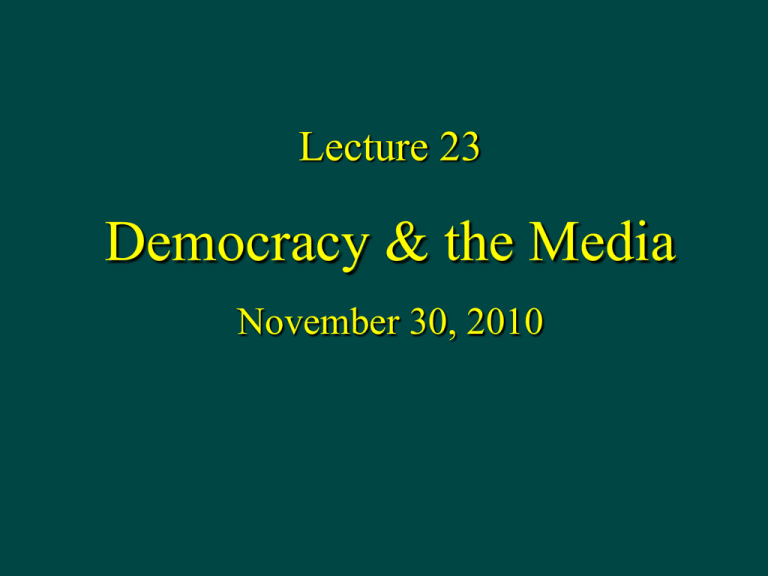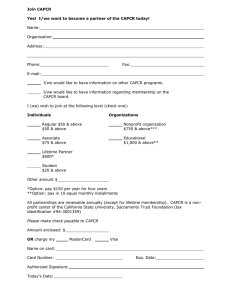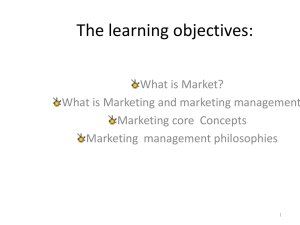Democracy & the Media Lecture 23 November 30, 2010
advertisement

Lecture 23 Democracy & the Media November 30, 2010 I. The problem • Democracy requires well-informed citizens. • This requires a press that is not manipulated by the state = a “free press”. • But it is very expensive to produce and disseminate good quality information. • Therefore the organizations which are best able to disseminate information tend to be large, very wealthy corporations. • Does this provide sufficient good information for citizens of a democracy? II. Markets and the media II. MARKETS & THE MEDIA 1. The Standard View • The free press = the free market press = free from government regulation = the “free marketplace of ideas”: only the best ideas (just like products) will survive the competition of the market • Assumptions: perfect competition and “consumer sovereignty” will insure open arena for dissemination of ideas and information. • Training and professionalism of journalists insures “objectivity” • The only serious threats to a free press is government authority II. MARKETS & THE MEDIA 2. Problems with the Standard View Problem #1. Private corporate control of media content Simple fact: private wealthy owners have the right and the power to control content of news. Question: is this likely to create a basic pro-business bias within the media? Consequences • News content is broadly constrained by the interests of owners • The spectrum of “legitimate” opinion is from the moderate liberal to extreme right • Journalists may be relatively liberal, but they do not control what gets into the news. Reporters and editors are almost always severely constrained by the interests of media owners and advertisers. II. MARKETS & THE MEDIA 2. Problems with the Standard View Problem #2. From competition to Oligopoly A profit-driven, market-oriented newspaper and media system has an inherent tendency to lead to concentration: huge newspaper chains in which most cities have only one newspaper. This eliminates competition. Consequences • Huge barriers to entry for nonprofit media • Particularly severe problem for TV news • Can the internet counteract this? Maybe, BUT a major problem is the huge cost of investigating and reporting high quality news. II. MARKETS & THE MEDIA Concentration of Media Ownership Number of corporations that dominate the media industry 50 45 40 35 30 25 20 15 10 5 0 early 1980s early 1990s today II. MARKETS & THE MEDIA 2. Problems with the Standard View Problem #3. Advertising and profit maximization Profit-maximizing news media make money almost entirely because of advertising. The marketing objective is to be viewed by people who are as attractive to advertisers as possible = people with money to buy things. Consequences • News is geared to what is of interest to the affluent, not the average person • News is designed to be inoffensive to advertisers • News that is relevant to the “public interest” or “common good” is marginalized • Newspapers want to avoid offending anyone very much. II. MARKETS & THE MEDIA 2. Problems with the Standard View Problem #4. Cost-cutting vs quality as basis for competition The general bottom-line preoccupation of investors in American corporations means that short-term profit-maximization becomes the central focus of media CEOs and pressures for cost-cutting increase. Consequences • Cheaper to have media filled with news from syndicated sources than hire one’s own journalists. • Increased reliance on press reports and “media events” as sources of news. News is increasing generated by elites in their own interests rather than by independent journalists. Public relations and Press releases = 50-70% of “news”. • Result = massive downsizing of journalist staffs, closing foreign offices, decline of investigative journalism. II. MARKETS & THE MEDIA 3. Deregulation: the case of radio • Radio spectrum is part of the “public commons” and so its use has until recently been heavily regulated. • Before 1996 a single firm could only own one radio station is a given market, and other restrictions across markets. • 1996 Telecommunications Act removed most regulations on ownership. • Now: Clear Channel Radio owns 1,200 stations nationwide = almost 30% of market controlled by one corporation. • Note: almost no economies of scale in radio. What is more efficient is the ability to attract advertising which makes it very hard for local stations to compete for advertising revenues. II. MARKETS & THE MEDIA III. Alternatives: revitalizing a democratic free press III. ALTERNATIVES 1. A Fundamental Idea A vibrant, high quality free press in the public interest is a public good. Capitalist markets generally do a poor job in providing public goods; public goods need some kind of systematic public support. III. ALTERNATIVES 2. Three kinds of broadcast media: commercial, state, and nonprofit/community media • The media system in the US is dominated by private commercial firms • Other places in the world have a much stronger public, noncommercial sector paid to a significant extent by taxes. In the U.K. you pay a license fee to have a TV which pays for the BBC. • Public broadcasting the US is heavily dependent on donations. Less that 15% from taxes. • Problem for nonprofit, noncommercial community broadcasting is the free-rider problem: you can listen to public radio even if you don’t pay for it. Only 10% of listeners contribute. III. ALTERNATIVES 3. Toward a Democratic Media System What would it take to create a vibrant, democracy-enhancing media system in the United States? Some key elements would include: 1. Media empires and conglomerates should be prohibited in the public interest: break up the chains. 2. The public, noncommercial, nonprofit media sector should be the dominant sector in broadcasting, with the commercial sector adapting to this. 3. Encourage diverse forms of ownership: employee cooperatives, community stations, university, non-profit corporations. All of these need subsidies. 4. Provide public subsidies but without state control. III. ALTERNATIVES 4. Two ways of providing public subsidies of information media as a public good • Return airwaves to public control and treat as a public resource. It should be leased, and the rents from the leases should be used to support public sector broadcasting, including community and nonprofit radio, television and newspapers. Rents could supply up to $2-4 billion/year subsidy. • Targeted Tax Credit (not tax deduction) for nonprofit media support – the Nichols/McChesney proposal for a $200 tax credit for newspaper subscriptions.




